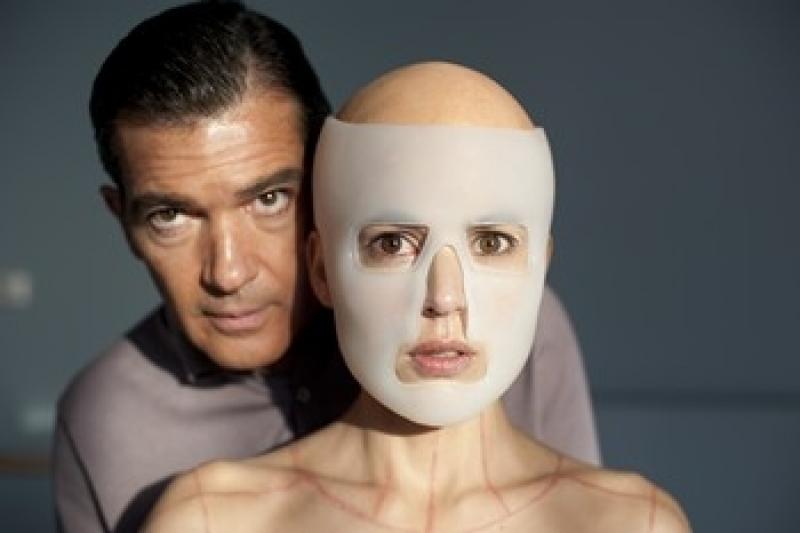The Skin I Live In | reviews, news & interviews
The Skin I Live In
The Skin I Live In
Almodóvar carves his elegant body horror flick with the precision of a surgeon’s blade

Cinematic virtuoso Pedro Almodóvar’s contribution to the body horror subgenre is a sumptuous nightmare with the precision and looming malevolence of its psychotic surgeon’s blade. His 19th feature is a film for our age – an age which has seen radical and sometimes grotesque surgical reinvention - concerned as it is with the troubling question: what actually lies beneath?
Based fairly loosely on the novel Tarantula by Thierry Jonquet, The Skin I Live In reunites Almodóvar with his former leading man of choice, Antonio Banderas. Banderas plays Robert Ledgard, a cutting-edge (excuse the pun), indecently rich plastic surgeon residing in a luxury manor-turned-fortress on the outskirts of Toledo, Spain. Ledgard has been indulging in dubious scientific experimentation which has led him to create a highly resilient brand of artificial skin.
Even more alarmingly, Ledgard has been conducting his scientific trials on a captive human subject. His prisoner is the enigmatic Vera (Elena Anaya), whom he seems to resent and desire in equal measure. She is confined to a single room in his extravagant abode, exhaustingly eyeballed by multiple cameras and whiling away her days exercising and meditating, attired bizarrely in a flesh-coloured body suit. After she implores that he free her - so that they may live as a "normal" couple - he recoils from her advances in apparent disgust, but immediately retires to continue observing her reaction writ large on his enormous private screen.
It’s a film with its fair share of secrets to reveal – precious few of which you will stumble upon here. Although we learn early on that Vera has been sculpted in the image of Ledgard’s late wife, the pertinent question is this: who exactly looks out from behind her impossibly immaculate façade? Similarly mysterious is Marilia (Almodóvar regular Marisa Paredes), Ledgard’s hopelessly devoted housekeeper who seems to acquiesce and even assist in the imprisonment of the young woman.
 As Vera, Almodóvar has appositely cast Elena Anaya (pictured right), who had a small role in 2002’s Talk to Her. She's an actress of show-stopping beauty with a face many women would pay a surgeon to forge. Furthermore she often appears bathed in a hyper-real glow, her skin almost tangibly soft, frequently reminiscent of the images from cosmetic advertising, dewy and airbrushed - real yet surreal. However, Anaya is undeniably more than a pretty face, giving a heart-wrenching, petal-delicate performance and fully realising the complications of her character. Crucially it’s a performance which also withstands the all-important second viewing.
As Vera, Almodóvar has appositely cast Elena Anaya (pictured right), who had a small role in 2002’s Talk to Her. She's an actress of show-stopping beauty with a face many women would pay a surgeon to forge. Furthermore she often appears bathed in a hyper-real glow, her skin almost tangibly soft, frequently reminiscent of the images from cosmetic advertising, dewy and airbrushed - real yet surreal. However, Anaya is undeniably more than a pretty face, giving a heart-wrenching, petal-delicate performance and fully realising the complications of her character. Crucially it’s a performance which also withstands the all-important second viewing.
As her jailer, Banderas also impresses. Interestingly, this is not the first time that he’s played a kidnapper for Almodóvar. He did so in the sexual-violence farce Tie Me Up! Tie Me Down! (1990) but Ledgard is a very different beast to that film’s Ricky; he is hard, unreadable, and his monstrous nature lurks behind a refined, seemingly impenetrable veneer.
Is he damning us all to his mad scientist's designs? There are many fascinating dimensions to the The Skin I Live In, most of which can’t be discussed without divulging pivotal plot details but, suffice to say, there are several instances of history repeating itself and a particularly shocking reminder of adultery which prompts a too-good-to-resist opportunity for revenge. Almodóvar has also made the interesting decision to set the film negligibly in the future, in 2012. Is he perhaps saying that the alarming advances in science are just around the corner? Is he damning us all to his mad scientist’s designs?
Despite the flesh and frantic strings, this never approaches the bloodthirsty, hysterical horror of a giallo, retaining an unmistakably Almodóvarian flavour (still mad, then, but not that mad) and even a little of his more outré humour. At its most fundamental level it resembles Frankenstein (or should that be Bride of, or even the more appropriately prurient Flesh for Frankenstein?), but there’s also ample reference to the magnificence of Eyes Without a Face (1960) and Vertigo (1958).
The Skin I Live In isn’t vintage Almodóvar, who works best freed from the confines of genre cinema (see also 2009’s mildly disappointing thriller Broken Embraces). The development of the characters and their tempestuous relationships - usually an Almodóvar strength - sometimes suffers from the need to unfurl the labyrinthine plot. Additionally, if you’re in it for surgical horror you’re better off purchasing The Human Centipede (2009) as, although it’s conceptually frightening and disarming enough, there’s very little bloodshed and it’s totally devoid of scares. No, this is an altogether more elegant chiller. It’s mesmerising, rich and thought-provoking - thoroughly classy, but perhaps a little too cold.
Watch the trailer for The Skin I Live In
The future of Arts Journalism
You can stop theartsdesk.com closing!
We urgently need financing to survive. Our fundraising drive has thus far raised £49,000 but we need to reach £100,000 or we will be forced to close. Please contribute here: https://gofund.me/c3f6033d
And if you can forward this information to anyone who might assist, we’d be grateful.

Subscribe to theartsdesk.com
Thank you for continuing to read our work on theartsdesk.com. For unlimited access to every article in its entirety, including our archive of more than 15,000 pieces, we're asking for £5 per month or £40 per year. We feel it's a very good deal, and hope you do too.
To take a subscription now simply click here.
And if you're looking for that extra gift for a friend or family member, why not treat them to a theartsdesk.com gift subscription?
more Film
 Honey Don’t! review - film noir in the bright sun
A Coen brother with a blood-simple gumshoe caper
Honey Don’t! review - film noir in the bright sun
A Coen brother with a blood-simple gumshoe caper
 The Courageous review - Ophélia Kolb excels as a single mother on the edge
Jasmin Gordon's directorial debut features strong performances but leaves too much unexplained
The Courageous review - Ophélia Kolb excels as a single mother on the edge
Jasmin Gordon's directorial debut features strong performances but leaves too much unexplained
 Blu-ray: The Graduate
Post #MeToo, can Mike Nichols' second feature still lay claim to Classic Film status?
Blu-ray: The Graduate
Post #MeToo, can Mike Nichols' second feature still lay claim to Classic Film status?
 Little Trouble Girls review - masterful debut breathes new life into a girl's sexual awakening
Urska Dukic's study of a confused Catholic teenager is exquisitely realised
Little Trouble Girls review - masterful debut breathes new life into a girl's sexual awakening
Urska Dukic's study of a confused Catholic teenager is exquisitely realised
 Young Mothers review - the Dardennes explore teenage motherhood in compelling drama
Life after birth: five young mothers in Liège struggle to provide for their babies
Young Mothers review - the Dardennes explore teenage motherhood in compelling drama
Life after birth: five young mothers in Liège struggle to provide for their babies
 Blu-ray: Finis Terrae
Bleak but compelling semi-documentary, filmed on location in Brittany
Blu-ray: Finis Terrae
Bleak but compelling semi-documentary, filmed on location in Brittany
 Oslo Stories Trilogy: Sex review - sexual identity slips, hurts and heals
A quietly visionary series concludes with two chimney sweeps' awkward sexual liberation
Oslo Stories Trilogy: Sex review - sexual identity slips, hurts and heals
A quietly visionary series concludes with two chimney sweeps' awkward sexual liberation
 Sorry, Baby review - the healing power of friendship in the aftermath of sexual assault
Eva Victor writes, directs and stars in their endearing debut feature
Sorry, Baby review - the healing power of friendship in the aftermath of sexual assault
Eva Victor writes, directs and stars in their endearing debut feature
 Blu-ray: Who Wants to Kill Jessie?
Fast-paced and visually inventive Czech comedy
Blu-ray: Who Wants to Kill Jessie?
Fast-paced and visually inventive Czech comedy
 Oslo Stories Trilogy: Love review - freed love
Gay cruising offers straight female lessons in a heady ode to urban connection
Oslo Stories Trilogy: Love review - freed love
Gay cruising offers straight female lessons in a heady ode to urban connection
 Beating Hearts review - kiss kiss, slam slam
Romance and clobberings in a so-so French melodrama
Beating Hearts review - kiss kiss, slam slam
Romance and clobberings in a so-so French melodrama

Add comment